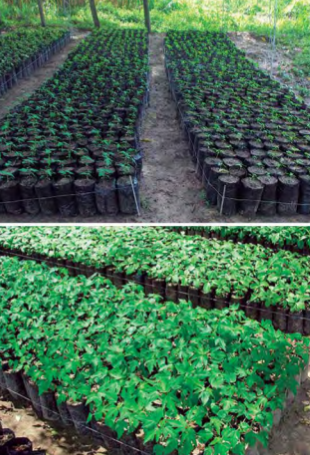Establishment of milky nurseries with agroecological practices
Abstract
Lechosa or papaya Carica papaya L. is a native fruit of Tropical America, important in the Venezuelan diet. The area sown in 2015 was 11,205 hectares, occupying the seventh place among fruit trees (FEDEAGRO, 2017).
Lechoceros can grow in most tropical soils, as long as the soils have good moisture retention capacity and are well drained. It does not tolerate pools in areas close to its roots for more than 48 hours. The temperature limits are between 21 and 33 ° C and annual rainfall between 1,500 and 2,000 millimeters.
There are different methods of propagation of this plant, however, the seed method is the most practical and the most widely used from a commercial point of view. To maintain the purity of the cultivar or material to be sown, the seeds must come from selfed flowers (hermaphrodites) or from controlled cross-pollination. In the latter case, the plants should be separated from male flowering plants by 1,000 to 1,600 meters.
The sowing of the seed can be done directly in the field, in seedbeds with transplantation and by nurseries for subsequent transplantation. Direct sowing in the field is not widely used, it needs a large amount of seeds per hectare (from 15 to 20 seeds per planting point), which would be very expensive when depending on the purchase of commercial seed. For sowing by seedbeds, it is necessary to have beds with disinfected soil or substrate, however, the roots of the plants suffer more stress during transplantation to the field. The most used sowing method in Venezuela is by nursery.
References
FEDEAGRO. 2017. Estadísticas de producción vegetal en Venezuela. Superficie cosechada (en línea). Venezuela. Consultado 24 abr.2017 http://www.fedeagro.org/produccion/Rubros.asp
Gómez M. A. y D. M. A. Ormeño. 2013. Selección de semilla y establecimiento de vivero para cacao. Maracay (VE) Instituto Nacional de Investigaciones Agrícolas. 48 p. Versión digital: ISBN 978-980-318-289-2.
Ormeño D., M. A., N. Terán. y J.C. Rey. 2013. Evaluación de diferentes abonos orgánicos en el desarrollo de plantas de guayaba (Psidium guajava L.) y calidad de los suelos en vivero. Rev. Agron. Trop. 63 (1-2): 73-84 pp.
Ormeño M. A., D. Ormeño y A. Zambrano. 2011. Los cultivos asociados al cacao (Theobroma cacao L.) como parte de un agroecosistema son una alternativa para el mejoramiento de la calidad de los suelos. J. Interamer. Soc. Trop.l Hort., Vol. 53. 31-33 pp. ISSN (on line) 2237-4264, ISSN (print) 2237-4256.
Ormeño D., M. A. y A. Ovalle. 2007. Producción y aplicación de abonos orgánicos. Revista INIA Divulga, N° 10:29-35. Maracay (Venezuela), enero-diciembre 2007.


